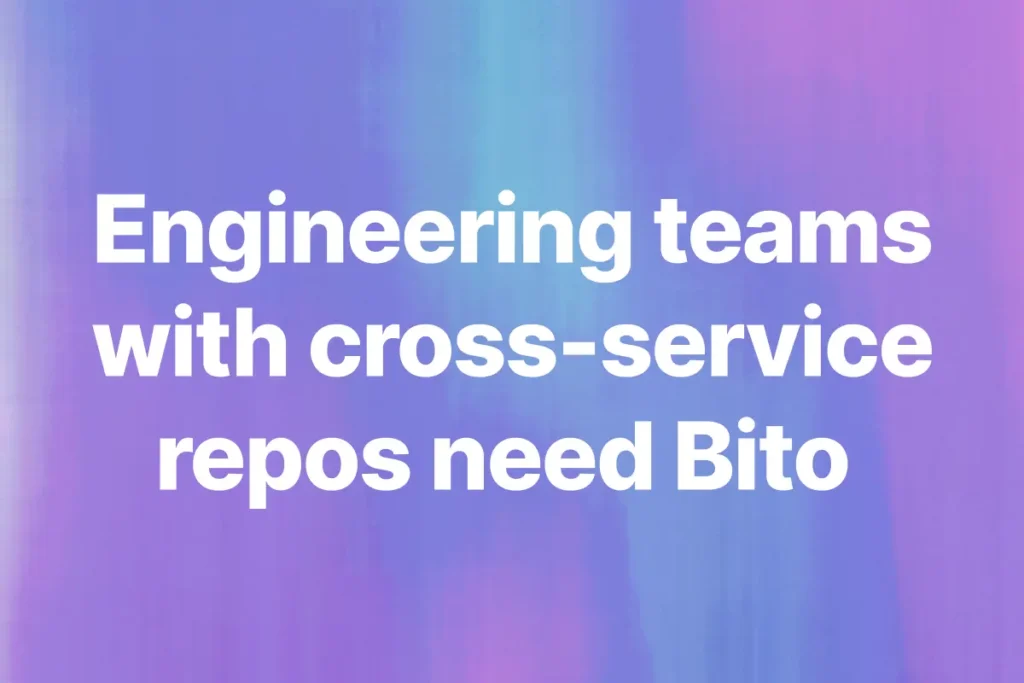In the modern-day development landscape, writing better and faster code is no longer a luxury, but a necessity. As developers, we constantly look for tools that can streamline our workflow and boost our coding prowess. This is where Bito, the AI software platform that supercharges developers’ productivity, shines by integrating seamlessly with our IDEs and offering intelligent code suggestions.
In this article, we will take a deep dive into the features and provide a hands-on use case for Bito’s 10X Developer Plan. You’ll discover how it can help you write code more efficiently and gain a better understanding of your codebase.
Bito Features
Before we delve into Bito’s 10X Developer Plan features, let’s take look at the features Bito provides in both plans:
- IDE Integration: Seamless integration with popular IDEs like Visual Studio Code, IntelliJ, etc.
- Custom Prompt Templates: Enables users to create and save custom prompt templates for IDEs, enhancing personalization.
- Expanded Contextual Memory: Capable of processing up to 40,000 characters, allowing for complex and context-aware interactions.
- Diff View Feature: Offers a side-by-side comparison of changes proposed by the AI, enhancing control over code modifications.
- Security and Performance Checks: Provides specific shortcuts for checking code for security, performance, and style issues.
- Interactive Chat Experience: Enables context-aware chat for interactive sessions with follow-up questions.
- Automatic CLI Updates: Keeps users updated with the latest enhancements automatically.
- Accessibility Features: Ensures keyboard accessibility to all UI elements.
- Multilingual Support: Supports multiple languages for the Bito’s AI chat input (prompt) and output (response from AI), enhancing accessibility.
- Customizable Keyboard Shortcuts: Allows users to configure keyboard shortcuts for a more streamlined experience.
- Integration with GPT-4: Utilizes GPT-4 for detailed and accurate responses to programming-related queries.
- Tailored for Coding: Specifically designed to assist in coding tasks.
Bito 10X Developer Plan Features
The Bito 10X Developer Plan isn’t merely an upgrade from its Free plan; it’s a redefinition of what a code assistant can achieve. Let’s break down the features that set it apart:
Advanced AI-Powered Coding:
Powered by GPT-4, one of the latest and most advanced AI models, Bito’s 10X Developer Plan takes code generation and suggestion to a whole new level. Unlike the GPT-3.5 model utilized in the Free plan, GPT-4’s deep learning capabilities ensure more accurate and context-aware suggestions.
Project-wide Code Analysis and Optimization – AI that understands your code
“AI that understands your code” in Bito’s 10X Developer Plan transcends the conventional script-level analysis, offering a holistic examination of an entire project or codebase. It empowers developers to not only identify performance bottlenecks but also to conduct thorough security checks across the project. With the ability to ask specific questions or request optimizations, developers can leverage this feature to enhance code performance, ensure security compliance, and gain insightful recommendations on a project-wide scale. This feature, harnessed with GPT-4’s prowess, sets a new benchmark in project-level code analysis and optimization.
Expanded Contextual Memory:
With a whopping 240,000 characters context length, Bito can analyze larger code segments, identifying patterns and relationships effortlessly. This is crucial in complex projects where understanding the broader context is key to generating relevant code suggestions.
Priority Service:
No more waiting during peak times. The priority service ensures that your requests are processed swiftly even when the system is bustling with requests.
Coming Soon – Smart Bots and Advanced Code Understanding:
With unlimited repository access and smart bots on the horizon, Bito is promising a future where your AI assistant will understand your code in a much deeper sense, opening doors for more personalized and precise code suggestions.
Now, let’s move onto a real-world use case that highlights the prowess of the 10X Developer
Use Case Comparison
Use case 1: Debugging Memory Leaks in a Complex Script
Navigating through a complex script to identify memory leak issues can be like looking for a needle in a haystack. However, with Bito’s 10X Developer Plan, the process is no longer daunting. The ‘Insert Code Selected in IDE’ feature, coupled with GPT-4’s intelligent analysis, pinpoints the problematic code chunks with precision. This not only saves invaluable time but also enhances code quality by ensuring such critical issues are addressed promptly. Bito’s advanced version proves to be an indispensable tool for developers, turning the tide in their favor in the battle against memory leaks. Additionally, the expanded contextual memory allows Bito to provide relevant suggestions even in a vast codebase, making the development process smooth and efficient.
Debugging a Memory Leak
In this use case, I utilized Bito to identify memory leak issues in a complex Python script. By selecting the script in my IDE and leveraging Bito’s ‘Insert Code Selected in IDE’ feature, Bito was able to accurately pinpoint the memory leaks within the add_data method and process_data function. Bito’s insightful analysis, powered by GPT-4, facilitated a seamless debugging experience, enabling swift and efficient error resolution. This scenario highlights Bito’s superior problem-detection capabilities, making the advanced version an invaluable asset for developers aiming to maintain high-quality code in their projects.
Code:
import weakref
class DataHolder:
def __init__(self):
self.data = []
def add_data(self, size):
for i in range(size):
self.data.append({"id": i, "name": f"Name {i}"})
def create_data(data_holder, size):
while True:
data_holder.add_data(size)
# Simulate some processing
process_data(data_holder.data)
def process_data(data):
large_dict = {i: weakref.ref(large_dict) for i in range(1000)}
def main():
data_holder = DataHolder()
create_data(data_holder, 1000000)
if __name__ == "__main__":
main()
Bito identifies the memory leak issue in the code and suggests some more issues with the code like the infinite loop, performance issue and memory consumption.
Finally, Bito suggests the following changes to the code:
Here’s how you can fix the issues: 1. Infinite Loop: If you want to limit the loop to a certain number of iterations, you can use a for loop instead of a while loop. If you want the loop to run based on a certain condition, you can add a condition to your while loop. 2. Weak Reference to Non-existent Object: You should create the object first before creating a weak reference to it. 3. Unused Objects: If large_dict is not used, it’s better to remove it. 4. Memory Management: You can add a condition to limit the size of the data list. For example, you can remove the oldest data when the list reaches a certain size. 5. No Data Cleaning: You can delete the data that has been processed. For example, you can use the del statement or the list.pop() method. 6. No Exception Handling: You can add try/except blocks to handle exceptions. Here’s an example of how you can fix the code:
import weakref
class DataHolder:
def __init__(self):
self.data = []
def add_data(self, size):
for i in range(size):
self.data.append({"id": i, "name": f"Name {i}"})
# Limit the size of the data list to 100000
if len(self.data) > 100000:
self.data.pop(0)
def create_data(data_holder, size):
for _ in range(10): # Run the loop 10 times
data_holder.add_data(size)
# Simulate some processing
process_data(data_holder.data)
def process_data(data):
try:
large_dict = {i: weakref.ref(data) for i in range(1000)}
except Exception as e:
print(f"An error occurred: {e}")
def main():
data_holder = DataHolder()
create_data(data_holder, 1000000)
if __name__ == "__main__":
main()
This is just a basic example. You should adjust the code according to your specific needs.
Use case 2: Harnessing AI to Understand and Refine Your Codebase
In the realm of software development, having a tool that comprehends your entire codebase and provides intelligent insights is revolutionary. With Bito’s “AI Understand Your Code” feature, indexing a repo becomes a gateway to a plethora of intelligent suggestions. The expanded contextual memory, powered by GPT-4, not only understands your code but can traverse through an entire project, offering invaluable suggestions. Bito ensures complete privacy as it doesn’t store your code, addressing data security concerns. This feature is a testament to how Bito is revolutionizing coding, making it a seamless, efficient, and secure endeavor.
Leveraging Bito for Enhanced Performance in a Sign Language Recognition Project
After indexing the Sign Language Recognition repository, I utilized Bito’s “AI Understand Your Code” feature to inquire about optimizing the Tensorflow model parameters for better accuracy. With its GPT-4 integration and expanded contextual memory, Bito navigated through the codebase, suggesting specific parameter adjustments. I further asked Bito for recommendations on enhancing image preprocessing within the project, to which it provided actionable suggestions. This interaction was not only insightful but also privacy-centric, as Bito doesn’t retain any project data, ensuring secure interactions. This exercise showcased Bito’s capability in offering valuable insights for improving code efficiency in complex projects.
Question:
“How can I optimize the Tensorflow model parameters for better accuracy?”
Bito’s Response:
Here are some ways to optimize the Tensorflow model parameters for better accuracy: In cnn.py , you can: – Increase the number of convolutional layers. Adding more layers can help learn more complex patterns in the data. – Increase the number of filters in each layer. More filters mean the model has more feature maps to learn from. – Use dropout regularization to prevent overfitting. Add Dropout layers after dense layers. – Use data augmentation techniques like random rotation, zooming, shearing, etc. to increase the diversity of data. – Increase the size of the training data. More data means the model can learn better. – Try different activation functions like ReLU , LeakyReLU , PReLU , etc. – Add batch normalization for faster training and higher accuracy. – Use learning rate decay – decrease the learning rate over time for better convergence. – Add L2 or L1 regularization to prevent overfitting. In ASL.ipynb , you can: – Increase the number of epochs. More epochs mean the model can train for longer and learn better. – Try different optimizers like Adam , Adagrad , RMSprop , etc. Some optimizers may converge faster. – Adjust hyperparameters like learning rate, beta values, etc. for the optimizer. – Add validation data to evaluate the model during training. – Use early stopping to prevent overfitting. Stop training if validation loss does not decrease. In sign_language_pytorch.ipynb , similar techniques can be used. Some Pytorch specific optimizations are: – Use GPU to speed up training with model.to(device) – Use pretrained models like VGG, ResNet, etc. and fine-tune on your dataset. – Try mixed precision training with Apex for faster convergence. Hope this helps! Let me know if you have any other questions.
The “AI Understand Your Code” feature in Bito substantially simplifies the process of identifying optimizations for better accuracy in a TensorFlow model within a project repository. It meticulously navigated through the project files, pinpointing precise adjustments in various scripts. This feature not only showcased an ability to provide tailored suggestions across different files but also ensured a comprehensive understanding of the entire codebase. Unlike other platforms, Bito’s advanced feature-set, backed by GPT-4, enables developers to index their repositories, ask specific questions, and receive insightful suggestions on a whole repo, revolutionizing the code optimization process.
Use Case 3: Multilingual Debugging Assistance
In today’s global developer community, the language barrier can be a significant hurdle. However, with Bito’s multilingual support, this is no longer a concern. I tested Bito’s proficiency by posing the same query regarding identifying memory leaks, first in Hindi, followed by Spanish and French. Each time, Bito recognized the query, analyzed the script, and provided insightful suggestions in the respective language. This feature eradicates linguistic barriers, making Bito a truly global assistant, ready to assist in ironing out code issues regardless of the language you speak.
Multilingual Support for Memory Leak Issue
In this scenario, I reused the script from Use Case 1, but this time, I interacted with Bito in Hindi to identify the issues. The multilingual support in Bito’s 10X Developer Plan is genuinely remarkable, making it accessible to developers worldwide, breaking the language barrier in code analysis. It efficiently pinpointed the problem areas in the script. Check out the video to witness how I posed queries in Hindi, French, and Chinese, and received accurate responses each time, demonstrating Bito’s linguistic versatility in action.
Firstly, I explored Bito’s linguistic capabilities by posing queries in Hindi (transliterated to English script). Remarkably, Bito responded accurately in Hinglish, a blend of Hindi and English, making the interaction intuitive. The conversation flowed naturally as I sought guidance on identifying and fixing a code issue. Bito’s responses were precise and insightful, showcasing its ability to transcend language barriers while providing valuable coding assistance. The exercise was an eye-opener to Bito’s global appeal, bridging linguistic gaps, and making code debugging a breeze regardless of the language you speak. Check the video to see this fascinating interaction unfold.
Similarly, I asked the same question in French and Mandarin. Here is what Bito responded.
Conclusion
In conclusion, Bito’s 10X Developer Plan emerges as a crucial ally for developers, catering to various demands of modern coding environments. Its GPT-4 integration, real-time collaboration, extensive language support, and AI-powered code understanding are features that significantly elevate coding efficiency and project management. Whether it’s debugging, real-time code collaboration, or navigating through a complex machine learning project, Bito simplifies these tasks, making it an indispensable tool for serious developers and development teams. Through detailed use-cases, we saw how Bito’s advanced features can be harnessed to tackle real-world coding challenges, making it a worthy investment for any developer aiming for heightened productivity and code quality.
The use cases demonstrated Bito’s ability to debug memory leaks, optimize entire projects through the “AI Understand Your Code” feature, and offer multilingual support.
These capabilities, powered by GPT-4 and enhanced memory features, extend beyond mere code generation. They enable a deeper analysis and improvements across a project, showcasing a notable advancement in coding assistants. Along with other features like priority service and upcoming smart bots, Bito stands as a valuable tool for developers aiming for improved code efficiency and broader project oversight.
Bito’s 10X Developer Plan is not just an upgrade; it’s an investment towards better code, efficient collaboration, and a more intuitive coding experience.






